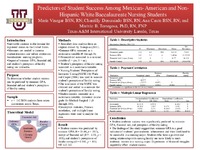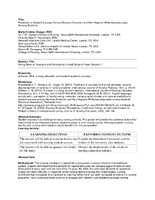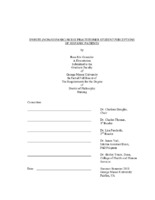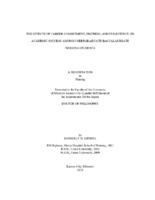| dc.contributor.author | Vinegar, Maria Cristina | en |
| dc.contributor.author | Demasiado, Chantilly Mae C. | en |
| dc.contributor.author | Cantu, Ana Laura | en |
| dc.contributor.author | Torregosa, Marivic B. | en |
| dc.date.accessioned | 2016-09-16T14:22:37Z | |
| dc.date.available | 2016-09-16T14:22:37Z | |
| dc.date.issued | 2016-09-16 | |
| dc.identifier | LEAD16PST76 | en |
| dc.identifier.uri | http://hdl.handle.net/10755/620222 | |
| dc.description | <p>Leadership Connection 2016 Theme: Personal. Professional. Global. Held at the Marriott Downtown, Indianapolis.</p> | en |
| dc.description.abstract | <p>Session presented on Sunday, September 18, 2016: Background: The ongoing shortage of registered nurses poses a serious threat to the healthcare system. Experts estimated that the demand for registered nurses will increase approximately at least three percent every year over the next 10 to 15 years. By 2020, the estimated demand for registered nurses will reach 285,000. In response to the nursing demand across the United States, nursing enrollment has increased. It is important to note that while there has been increased enrollment in nursing programs, many nursing schools continue to struggle with retention and academic success among nursing students. Due to the rigorous nature of a nursing major, student retention and attrition are major concerns and an ongoing challenge for many nursing faculty. To date, numerous studies have been conducted to determine factors that are influential towards student success yet only a few past studies have placed emphasis on entrance grade point average (GPA), financial aid, and student's perception of faculty caring as predictors of student academic success. Purpose: To determine whether student success can be predicted by entrance GPA, financial aid and student's perception of faculty caring. Design: In the original study, a correlational predictive research design was conducted to examine the relationship between student academic success and a set of predictors. Methods: For this paper, a secondary data analysis was conducted from an original dataset by Torregosa (2011). Entrance GPA was measured as a continuous variable (0 through 4); financial aid was measured as a nominal variable (1 = yes, 0 = no); and student's perception of caring was measured as a continuous variable. Nursing Students' Perceptions of Instructor Caring (NSPIC) by Wade and Casper (2006) was used to measure student's perception of faculty caring. The NSPIC is a 31- item instrument measured on a 6-point Likert scale. The total score of the NSPIC was obtained and served as a measure for student's perception of faculty caring. The outcome variable, student success, was measured as numerical course grade from the course Medical-Surgical 1 (0 through 100). Descriptive statistics, Pearson correlation, and multiple linear regression were used to analyze the data. IRB approval was obtained in the original study and for the secondary data analysis. Results: Student success was predicted by entrance GPA ( = 10.44, p < .001), receipt of financial aid ( = - 4.89, p < .001), and student's perceptions of faculty caring ( = 0.048, p < .05). Conclusion: Student academic success was significantly predicted by entrance GPA, financial aid, and perception of faculty caring. The findings of this study suggest that entrance GPA is a good indicator of students' past academic achievement and their likelihood to be successful in a nursing major. Students who have a positive and caring relationship with nursing faculty are more likely to reach academic success in a nursing major. Finally, experiences of financial struggles negatively affect student success. The findings of this study have implications towards institutional and nursing program policies.</p> | en |
| dc.language.iso | en_US | en |
| dc.subject | Entrance GPA | en |
| dc.subject | Nursing Education | en |
| dc.subject | Student Academic Success | en |
| dc.title | Predictors of student success among Mexican-American and Non-Hispanic White baccalaureate nursing students | en |
| dc.type | Poster | en |
| dc.rights.holder | <p>
All rights reserved by the author(s) and/or publisher(s) listed in this item record unless relinquished in whole or part by a rights notation or a Creative Commons License present in this item record.
</p><p>
All permission requests should be directed accordingly and not to the Sigma Repository.
</p><p>
All submitting authors or publishers have affirmed that when using material in their work where they do not own copyright, they have obtained permission of the copyright holder prior to submission and the rights holder has been acknowledged as necessary.
</p> | |
| dc.description.note | <p>Items submitted to a conference/event were evaluated/peer-reviewed at the time of abstract submission to the event. No other peer-review was provided prior to submission to the Henderson Repository.</p> | |
| dc.type.category | Full-text | en |
| dc.contributor.department | Non-member | en |
| dc.author.details | Maria Cristina Vinegar, RN; Chantilly Mae C. Demasiado, RN; Ana Laura Cantu, RN; Marivic B. Torregosa, RN, FNP | en |
| dc.conference.name | Leadership Connection 2016 | en |
| dc.conference.host | Sigma Theta Tau International | en |
| dc.conference.location | Indianapolis, Indiana, USA | en |
| dc.date.conferenceyear | 2016 | |
| dc.contributor.affiliation | Texas A&M International University, Laredo, Texas, USA | en |
| dc.description.reviewtype | Abstract Review Only: Reviewed by Event Host | en |
| dc.description.acquisition | Proxy-submission | en |






